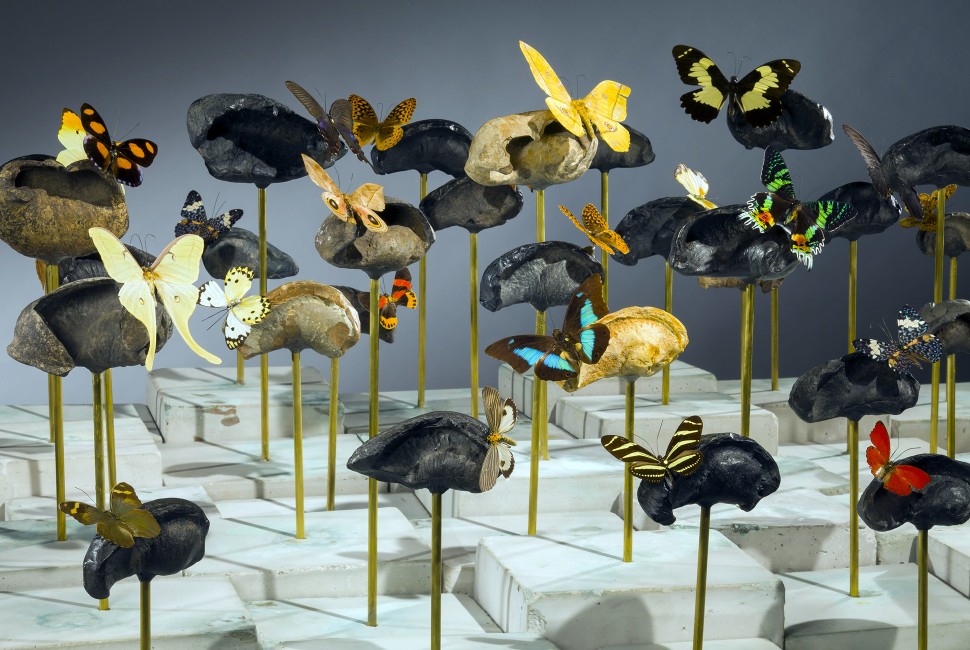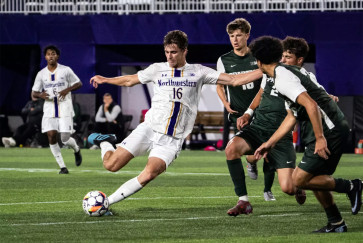American artist Dario Robleto believes artists and scientists share a common aspiration to increase the sensitivity of their observations.
From understanding the human body’s pulses and brainwaves to viewing the faintest glimmers of light from the edge of the observable universe, groundbreaking science pushes the limits of perception. Similarly, the perceptive work of artists can extend the boundaries of empathy and understanding.
Since 2018, Robleto served as an artist-at-large at the McCormick School of Engineering. This unique program partnership between The Block Museum and McCormick gave the artist an open “hall pass” to learn from, collaborate with and question scientists, engineers and experts from across the University.
Robleto’s residency concludes with the new exhibition “The Heart’s Knowledge: Science and Empathy in the Art of Dario Robleto.” Co-presented by The Block Museum and McCormick, the exhibition is on view now at The Block Museum.
A free opening conversation with the artist is scheduled for 2 p.m. Saturday, Feb. 4, in the McCormick Auditorium at Norris University Center.
An artist’s deepening engagement with science
Throughout the history of scientific invention, instruments like the cardiograph and the telescope have extended the reach of perception from the tiniest stirrings of the human body to the farthest reaches of space.
Robleto’s prints, sculptures and video and sound installations contemplate the emotional significance of these technologies, bringing viewers closer to the latent traces of life buried in the scientific record.
“The Heart’s Knowledge” represents a decade of Robleto’s creative practice, from 2012 to 2022, a period marked by a deepening engagement with science, including astronomy, synthetic biology and exobiology, and a widening embrace of new materials and creative forms, from 3D-printed objects to film.
Robleto dedicates the exhibition to Ann Druyan, the creative director of NASA’s Golden Record for the Voyager 1 and 2 projects. The record includes Druyan’s brainwaves and heartbeats, recorded as she reflected on her secret love for famed astronomer and future husband Carl Sagan. The act of sneaking “love on board the Voyager” inspired Robleto to compose a love letter to the only human whose “heart has left the solar system.”
Robleto sees Druyan’s act to include her emotions on the record as the central inspiration of his work. “I consider it the greatest work of subversive, avant-garde art not yet given its due,” Robleto said. “The Golden Record and Ann’s radical act brought us all together to think about what it means to be human — to one another and to unknown beings on other worlds.”
The exhibition organizes the artist’s conceptually ambitious, elegantly wrought artworks as a series of multisensory encounters between art and science. Each asks viewers to seek out the material traces of life in scales ranging from the intimate to the universal, and to question: Does empathy extend beyond the boundaries of time and space?
“Whether he’s addressing the most minute phenomena of the body or the horizons of the known universe, Robleto binds the rigor of scientific inquiry with artistic expression,” said exhibition curator Michael Metzger, The Block’s Pick-Laudati Curator of Media Arts.
“Straining at the bounds of observation, Robleto discovers unity at the limits; the common endeavor of art and science to achieve a form of knowledge that language alone cannot speak,” Metzger said.
Artist-at-large: Innovating where disciplines intersect
Lisa Corrin, the Ellen Philips Katz Executive Director of The Block Museum of Art, and Julio M. Ottino, dean of McCormick School of Engineering, envisioned the possibilities of this unconventional partnership between scientist and artist when they launched the artist-at-large initiative together. The work is part of an ongoing Art + Engineering initiative and a part of the whole-brain engineering philosophy at Northwestern Engineering.
“Here, a university’s school of engineering and its art museum come together in the shared belief that transformative innovation can happen at the intersections of usually distinct academic disciplines and modes of creativity and inquiry,” Corrin said. “We had faith that something meaningful would emerge organically if we merely provided structures in which informal interactions might take place.”
“We wanted to model for young engineers the value of embracing uncertainty as part of the journey that leads to innovation and opens pathways within the imagination — as artists do,” Ottino said. “We are grateful to Dario Robleto for accepting our invitation to come to Northwestern and to enter the unknown with us. He has taught us that our shared future resides in our capacity for compassion and for empathy, the ethos at the heart of his work that holds the most promise for those at the forefront of science in the interest of humankind.”
Visit The Block Museum site to learn more about “The Heart’s Knowledge: Science and Empathy in the Art of Dario Robleto.”
Lindsay Bosch is associate director of communications at The Block Museum of Art.


